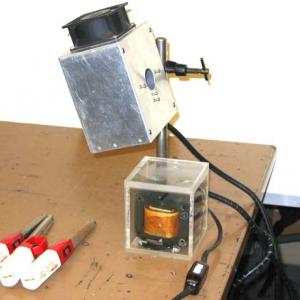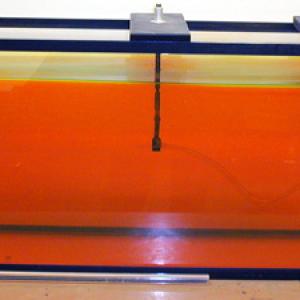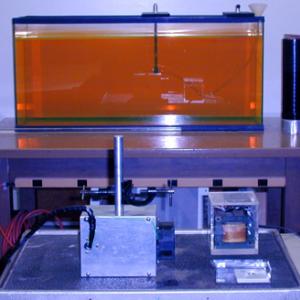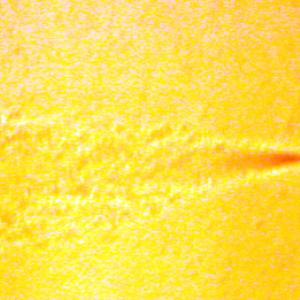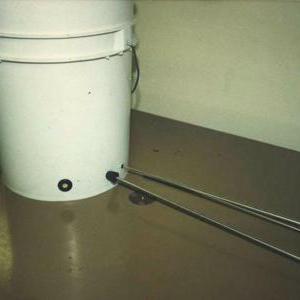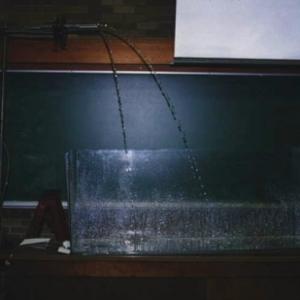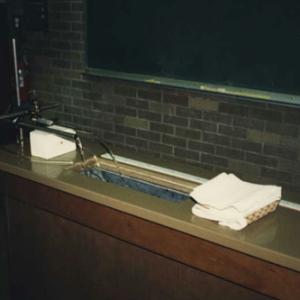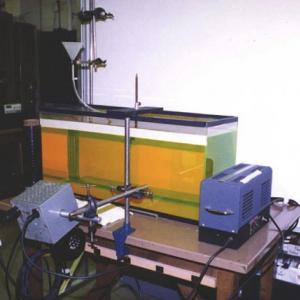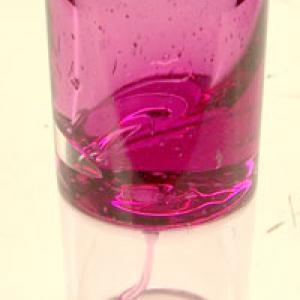College of Liberal Arts & Sciences
2C40.50 - Laminar and Turbulent Flow Demos
A very visual demonstration of laminar or turbulent flow can be done using the pin point light source and the lighters. Place the light about 10 feet from the screen and turn it on. With the lighter about 2 or 3 feet from the screen, turn it on and see the shadow on the screen that is created by the different indexes of refraction in the heated air. Observe the regions of laminar and turbulent flow.
Basically this method uses changes in refractive index to cast a shadow on the screen of the laminar and turbulent flow regions. Shine the pinpoint light source through the tank, at the nozzle and onto a screen behind the tank. Pointing the light upward through the tank will allow you to see the shadowgraph above tank height on the screen. A piece of masking tape along the top water level of the tank will eliminate the internal reflection from the top surface. The height difference between the funnel and the nozzle determines flow velocity. Using water that is hotter or colder than the tank water temperature determines whether the turbulent regions flow upward or sink. The Dewar is for carrying the hot or cold water. A VERY DRAMATIC DEMO!!
Laminar Flow: Insert the desired tubes into the 5 gallon bucket. Fill the bucket to a measure water height. While timing with a stopwatch unplug the ends of the tubes and catch the water from each tube in a separate graduated cylinder. At a desired time interval remove the graduated cylinders from each tube and measure the amount of water in each. The results from one of these experiments is enclosed with the calculations and a calculation of the errors as they deviate from theoretical.
Set the splash tank on the lecture bench with the drain hole over the lecture bench sink. Raise the tubes to a height where the water flow drops straight down when set at a certain flow rate. As the diameters of the tubes are a ratio of 1 to 2, the distance each water jet falls from the end of the tubes should be in a ratio of 1 to 4 (Increase the diameter by 2 and increase the flow rate by 4).
The Rheoscopic fluid will very easily show planes of shear fluid dynamics. Hand soap that has glycerol stearate in it will also show nice flow patterns when mixed with water. Glycerol di-stearate does not work as well.
- Sarah Lynn McGregor, Keith Goodale, "Don't Throw Away Your Old Overhead Projectors: Upcycle to Easy Physics Demos Instead", TPT, Vol. 63, #2, Feb. 2025, p. 107.
- Said Shakerin, "Meandering", TPT, Vol. 62, #3, March 2024, p. 165.
- Said Shakerin, "Improved Version of Double-Layered Enclosure Demo", TPT, Vol. 61, #9, Dec. 2023, p. 725.
- Said Shakerin, "Nonintuitive Flows Through Holes", TPT, Vol. 60, #5, May 2022, p. 325.
- Said Shakerin, "Improved Demo of Granular Flow", TPT, Vol. 58, #3, Mar. 2020, p. 147.
- Said Shakerin, "Fluids Demonstrations II: Bubbles in Mondrian Painting, Eruption-Like Flow, Rotational Instability, and Wake Vortices", TPT, Vol. 57, #9, Dec. 2019, p. 600.
- Said Shakerin, "Fluids Demonstrations: Trailing Vortices, Plateau Border, Angle of Repose, and Flow Instability", TPT, Vol. 56, #4, Apr. 2018, p. 248.
- Rod Cross, "Vertical Impact of a Sphere Falling into Water", TPT, Vol. 54, #3, Mar. 2016, p. 152.
- "Fluid Flow Disruption", TPT, Vol. 52, #8, Nov. 2014, p. 454.
- Camilla M. Saviz and Said Shakerin, "Serious Fun: Using Toys to Demonstrate Fluid Mechanics Principles", TPT, Vol. 52, #6, Sept. 2014, p. 332.
- Matthew T. Mawhinney, Mary Kate O'Donnell, Jonathan Fingerut, and Piotr Habdas, "Measuring Drag Force in Newtonian Liquids", TPT, Vol. 50, #3, Mar. 2012, p. 173.
- Richard Humbert, "Water Nozzles", TPT, Vol. 43, #9, Dec. 2005, p. 604.
- Stephen J. Van Hook and Michael F. Schatz, "Simple Demonstrations of Pattern Formation", TPT, Vol. 35, #7, Oct. 1997, p. 391.
- Volker Thomsen, "Estimating Reynolds Number in the Kitchen Sink", TPT, Vol. 31, #7, Oct. 1993, p. 410.
- Richard M. Heavers, "Submerged Horizontal Jets in Water", TPT, Vol. 30, #7, Oct. 1992, p. 423.
- Dean O. Kuethe, "Confusion About Pressure", TPT, Vol. 29, #1, Jan. 1991, p. 20.
- Richard M. Heavers and Maria G. Medeiros, "Laminar and Turbulent Flow in a Glass Tube", TPT, Vol. 28, #5, May 1990, p. 297.
- Angelo Armenti, "Questions Students Ask - Why is it Harder to Paddle a Canoe in Shallow Water?", TPT, Vol. 23, #5, May 1985, p. 310.
- J. A. Maroto, J. de Dios, and F. J. de las Nieves, "Use of a Mariotte Bottle for the Experimental Study of the Transition From Laminar to Turbulent Flow", AJP, Vol. 70, #7, July 2002, p. 698.
- Yakov Afanasyev, "Investigating Vortical Dipolar Flows Using Particle Image Velocimetry: An Experiment for the Advanced Undergraduate Laboratory", AJP, Vol. 70, #1, Jan. 2002, p. 86.
- Robert H. Stinson, "Classroom Demonstration of Streamline and Turbulent Flow", AJP, Vol. 59, #11, Nov. 1991, p. 1051.
- C. W. McCutchen, "Fluid Dynamic Phenomena Can Be Demonstrated With Stereo Shadowgraphs of Stratified Fluid", AJP, Vol. 44, #10, Oct. 1976, p. 981.
- Jaka Javh, "Visualizing Air Disturbances", Physics Today, Vol. 78, #2, Feb. 2025, p. 56.
- Charles R. Smith, "Aerodynamic Heating in Hypersonic Flows", Physics Today, Vol. 74, #11, Nov. 2021, p. 66.
- Grant B. Deane, Dale Stokes, and Adrian H. Callaghan, "Turbulence in Breaking Waves", Physics Today, Vol. 69, #10, Oct. 2016, p. 86.
- Charles Day, "Dissipation in Breaking Waves", Physics Today, Vol. 69, #5, May 2016, p. 21.
- Alexander J. Smits and Ivan Marusic, "Wall-Bounded Turbulence ", Physics Today, Vol. 66, #9, Sept. 2013, p. 25.
- Front Cover, Physics Today, Physics Today, Vol. 66, #9, Sept. 2013.
- "Taming Turbulence", Physics Today, Vol. 63, #4, Apr. 2010, p. 80.
- Mark Wilson, "Superhydrophobic Surfaces Reduce Drag", Physics Today, Vol. 62, #10, Oct. 2009, p. 16.
- William F. Vinen and Russell J. Donnelly, "Quantum Turbulence", Physics Today, Vol. 60, #4, Apr. 2007, p. 43.
- Gregory Falkovich and Katepalli R. Sreenivasan, "Lessons from Hydrodynamic Turbulence", Physics Today, Vol. 59, #4, Apr. 2006, p. 43.
- Richard Fitzgerald, "New Experiments Set the Scale for the Onset of Turbulence in Pipe Flow", Physics Today, Vol. 57, #2, Feb. 2004, p. 21.
- Charles Day, "Laser Technique Follows Turbulent Flow in Three Dimensions", Physics Today, Vol. 56, #3, Mar. 2003, p. 18.
- Stanley J. Micklavzina, "Demonstration Ideas", PIRA Newsletter, Vol. 5, #5, Mar. 1991.
- G. D. Freier and F. J. Anderson, "Fk-3", A Demonstration Handbook for Physics.
- D. Rae Carpenter Jr. and Richard B. Minnix, "F-290. Flow Rate vs. Tube Radius", DICK and RAE Physics Demo Notebook, 1993.
- T. Kallard, "Direct Shadow Demonstration (Shawdowgraphy)", Exploring Laser Light.
- Janice VanCleave, "20. Flowing Through", Engineering For Every Kid: Easy Activities that Make Learning Science Fun, p. 139.
- Jearl Walker, "3.47. Rumbling From Plumbing", The Flying Circus of Physics Ed. 2, p. 165.
- Jearl Walker, "3.36. Cigarette Smoke Stream", The Flying Circus of Physics with Answers.
- "211.30. Laminar and Turbulent Flow Demos", Heat and Fluids Book.
- Rafael M. Digilov, "Abstract: Weight-Detecting Capillary Viscometer", 2005 Apparatus Competition, Salt Lake City, UT.
- Journal Fluid Mechanics, 1980, Vol. 100, Part 3, p. 449 - 470.
- "Laminar and Turbulent Flow", Clouds in a Glass of Beer.
- Peter Weiss, "The Physics of Flutter", How it Works - Science Supplement, Spring 2000, p. 224 - 228.
- "Turbulent Orb", The Exploratorium Science Snackbook.
- Curt Suplee, "A Turbulent World", Everyday Science Explained, National Geographic, p. 52 - 53.
Disclaimer: These demonstrations are provided only for illustrative use by persons affiliated with The University of Iowa and only under the direction of a trained instructor or physicist. The University of Iowa is not responsible for demonstrations performed by those using their own equipment or who choose to use this reference material for their own purpose. The demonstrations included here are within the public domain and can be found in materials contained in libraries, bookstores, and through electronic sources. Performing all or any portion of any of these demonstrations, with or without revisions not depicted here entails inherent risks. These risks include, without limitation, bodily injury (and possibly death), including risks to health that may be temporary or permanent and that may exacerbate a pre-existing medical condition; and property loss or damage. Anyone performing any part of these demonstrations, even with revisions, knowingly and voluntarily assumes all risks associated with them.
